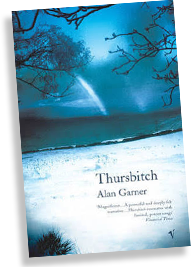
Finding the stone
It’s easy to miss the stone. I went along the road a few times before spotting it.
Click the map to see it’s exact location. It’s just past a metal gate on the right, above a fairly high verge.
The road is too narrow to park, so drivers need to find space around the spot marked ‘Nab End’ on the map.
What can it mean? Who was John Turner? Who cast him away in a heavy snow storm? And who was the mysterious lady who left a single footprint beside the frozen body? It sounds like an intriguing case for Sherlock Holmes! But even he would have struggled to piece together the clues from an 18th century stone standing beside a narrow country road.
The stone even seems to have inspired a novel; ‘Thursbitch’ by Alan Garner. (It’s received some good reviews and I’ve ordered a copy.) Click here to read Alan’s account of what led him to write the novel. Here’s what Alan has to say about John Turner;
John Turner lived at Saltersford Hall, where his father was a tenant farmer. He was born in 1706 and became a packman, or jagger, with a train of four horses.
His main occupation was carrying salt from Chester and Northwich to Derby, from where he would return with malt. His home in Saltersford* was ideally placed on this prehistoric trade route.
On Christmas Eve, 1735, (that is, when John was twenty-nine), he was on his way back from Northwich. It was snowing. But packmen were used to being on the road in all weathers and at all hours. They knew the hills better than anyone. They took no risks.
Jaggers were essential to their communities and yet at the same time mistrusted. Travel in eighteenth century England was not for ordinary folk. Most people didn’t move more than four miles from their birthplace in their entire lives.
Jaggers were looked on as boundary-striders, as Grendel is described in Beowulf, wild men, wodwose, as in Sir Gawain and the Green Knight. They belonged more to the hills than to the valleys.
Yet on that Christmas Eve, John Turner did not reach home. The next morning he was found dead, though his team of horses survived, covered by drifts. And by him, on the white, wind-smoothed land, was the single print of a woman’s shoe in the snow.
Which all leaves just as many questions as answers! I’ll update this page if I discover any more clues about John’s frozen death and the mysterious lady who left a single footprint in the snow.
*Saltersford isn’t marked on modern maps. Bit it was the same location as Jenkin Chapel.
Page update, Feb 2021: Michael on the Rainbow Old & New Facebook Group wrote: “…the original stone was moved and built into a wall of a house on Pedley Hill. The house is 3 or 4 storeys but very narrow front to back.” He also thought it was visible from the outside. I’ll update this page if I can get a photo.
Page update, May 2021: There’s some fascinating detail on this webpage about both John Turner and Jenkin Chapel.
Above: The replacement stone with the incorrect date. It’s since been moved higher up the slope to protect it from traffic.
Page update, January 2022: Many thanks to David on the Rainow Facebook Group for allowing me to reproduce his post confirming that the John Turner Stone isn’t the original, and also that the replacement has been moved twice – firstly further down the lane (see photos), and then further up the slope to better protect it from the traffic, possibly about 10-15 years ago.
Original stone replaced
I guess that most folk in Rainow who follow this group know of the memorial to John Turner on Ewrin Lane, but I have recently come across the history behind this stone in the anonymously authored The Story of Rainow, published in perhaps the 1970s-80s, so I thought it might be worth putting this together with my photos of the two most recent incarnations of this memorial.
The Story of Rainow states that James Mellor Jnr (1796-1879) of Hough Hole House “cut, inscribed and fixed the original stone in Ewrin Lane below Buxter Stoops recording the death during a snowstorm of John Turner.
The original stone has been replaced by the present one on which the date 1755 is incorrect. John Turner aged 29 ran a pack horse team and was the son of Richard Turner, Saltersford Hall, a trustee of Jenkin Chapel and uncle of James Mellor’s mother.
The following account is by Mrs [sic] W A Mellor, Manchester, and printed in the Manchester City News 1922 as told to him by his great uncle James Mellor:
John Turner who ran a pack horse team was making for his home at Saltersford Hall on Christmas Eve. His last stopping place was at Bollington and notwithstanding all entreaties to stay the night, as a terrible snowstorm was raging, he insisted on pushing on remarking that his folks would be waiting and he had never failed to get through. He set his face to the hills and that was the last seen of him alive.
Next morning a search party went out from his home and a little more than half a mile the leading horse was discovered under the snow on the sheltered side of the road. The remainder were strung out behind at various intervals all alive. The print of the woman’s shoe Mr James Mellor never made any attempt to explain.’
The bells of the pack horses eventually came into the possession of James Mellor with the exception of the bell of the leading horse. This bell went to Harrop House where it hung in a tree for a number of years and used to summon the farm workers for their meals etc.
Zephyrine posted this photo on the Rainow FB page (click to enlarge). He thinks one of the four slabs is the original John Turner Stone. And that it was inset into a garden wall at the Old Vicarage in Rainow, at the bottom of Tower Hill. I’d love to get a photo but it’s not proving that easy! I’ll update this page if I discover more.
Update: 24th March 2024: Many thanks to John, who now lives in the USA, for sending this link to a page about Alan Garner’s Thursbitch.
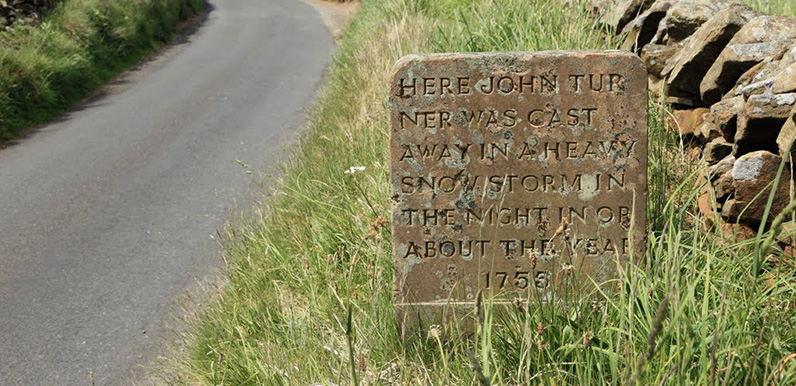
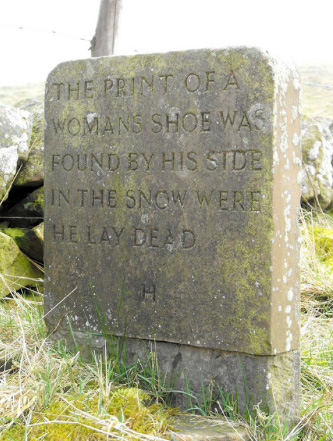
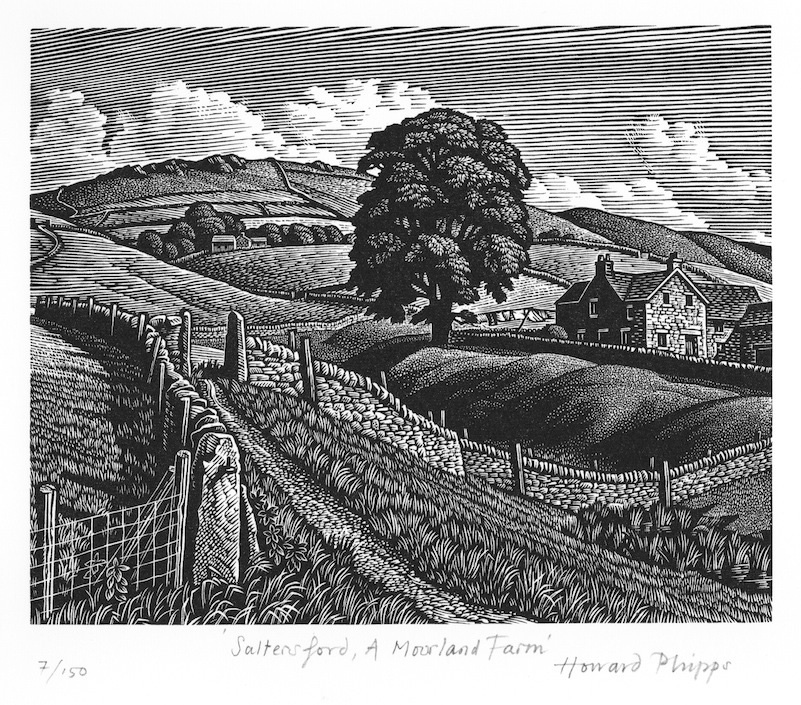
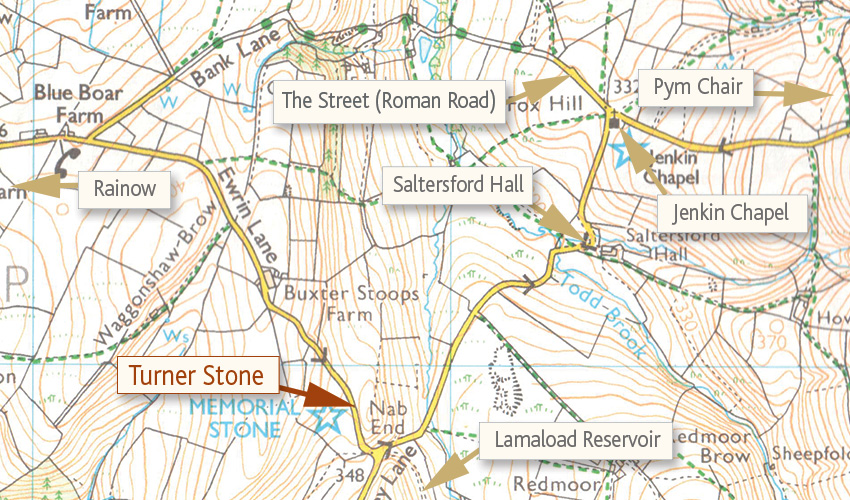
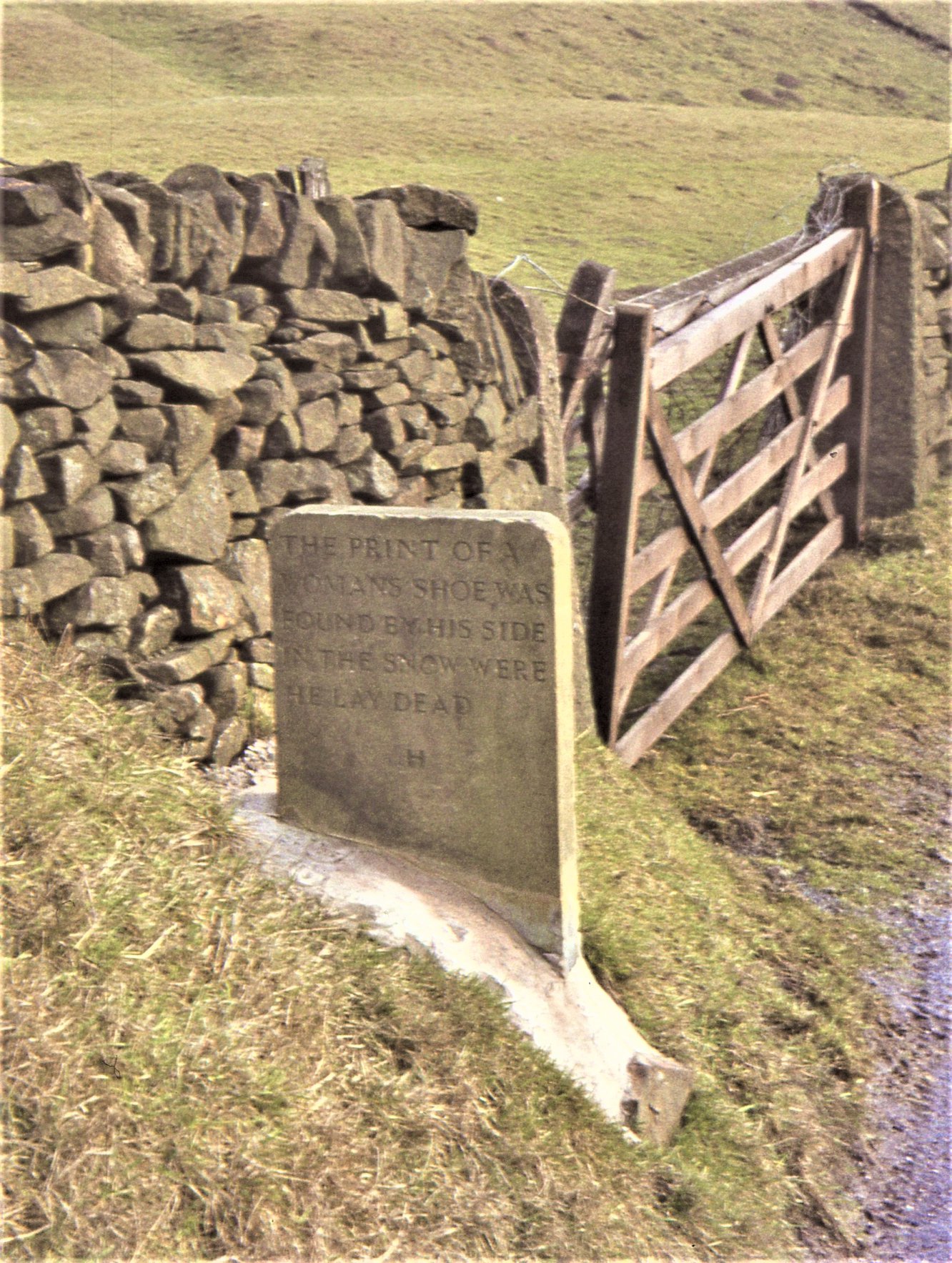
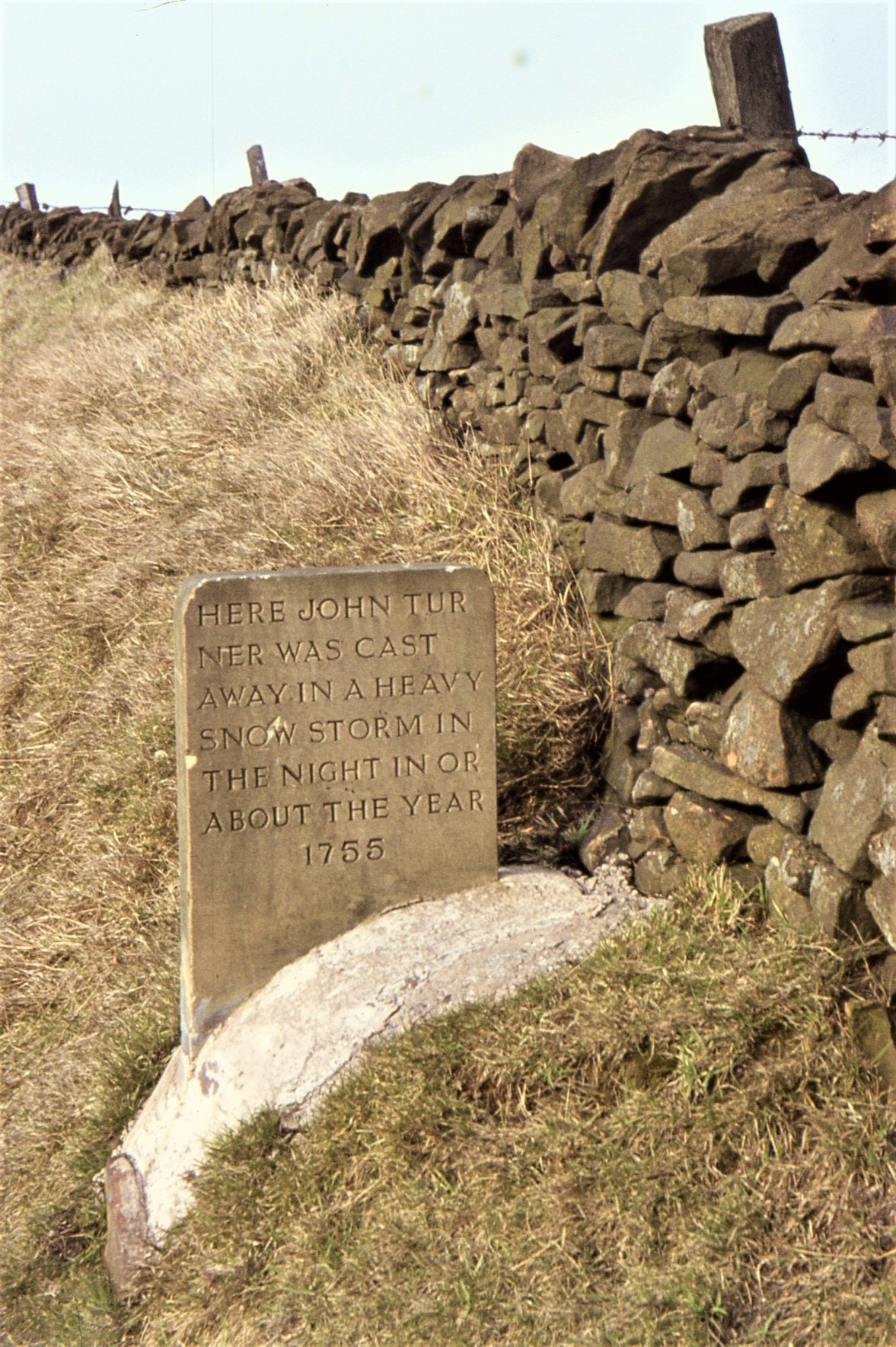
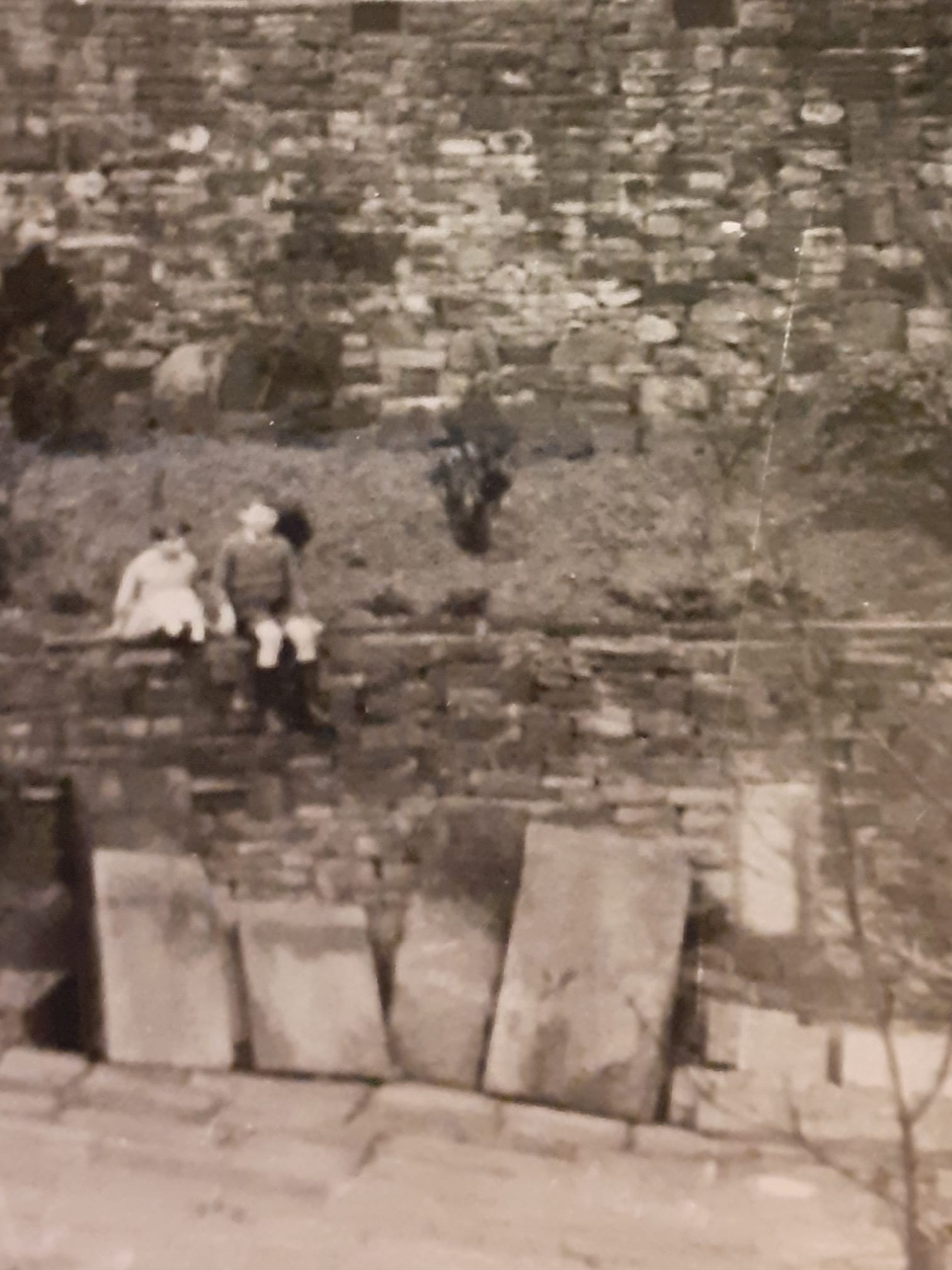
The stone says John died “in or about” 1755. But in fact the year was 1735. Perhaps the mason simply misread a 3 for a 5. But it shows that the stone must have been carved some years after the event. It will also have been moved when the road was widened and resurfaced.
Very interesting and as you say, more questions than answers. My story goes as follows: in the late afternoon of Friday, 24 Feb 2012 I was on my way back from Leicester to Bollington where I lived. Having recently moved there from South Africa I was intrigued by the snow and took a detour at Bosley to see more of it. The sun was shining but the hills in the Peak District were white. The scene along the river on the otherside of the Macc Forest was a splendud sight.
I crossed over the Cat and Fiddle road and started heading down into the Goyt Valley on Ankers Knowl Lane. I was probably 100 yards past the C&F road when I remembered that road got very steep a bit further on and decided to go back to the A road. But when I tried reversing my wheels just spun in the ice. I then decided to go down the first part of the hill, turn around and get out.
Unfortunately my car would only get halfway up the hill before getting stuck again. Time to abandon it and walk. I put every piece of clothing in my car on and started to walk. By now it was dark, the wind was howling and it was snowing. Like a drunk man, my eyes frozen and weaving around the road in the dark I headed up the hill.
I got a lift from a gent in what must have been one of the last cars driving on the A537 before it was closed by the police. By now the snow was about a foot deep but we got into Macc and then home in Clarence Mill, Bollington. The following day we were stopped by police from using the A537 and there were bulldozers clearing about 8 foot drifts off the road. I could see my car down in the valley but there was noways of getting to it. It was 2 days before I could get it out.
About 18 months later, I was driving on Ankers Knowl Lane and onto Erwin Lane to get to Bollington, the “scenic route” rather than the A523 but it was summer, and noticed John Turners memorial stone and realised what a dangerous situation I had been in but that 250 years ago he did not stand a chance in those conditions. I never noticed the “other side” of the stone and will go and have a look one day.
By the way, I have learnt how dangerous snowy conditions can be and how quickly the weather can turn. Africa may be wild and not for sissies, but that night I learnt a lesson. I would be interested to hear any more you find out about John Turner.
Regards
Glenn
Brilliant website for the historic interest – I am reading Alan Garner’s Thursbitch, and lacking even an old OS map from the days I rambled in your area, I turned to the online search for Jenkins Chapel. Your factual history is a superbly related asset for my purpose, sitting in a chair many miles from the scene – in Knoydart. Thank you for your writing and your photographs also. I shall return to this site as I keep putting down the book to find my feet!
Thanks for information – will pass on as I’m leading a walk from Pym Chair soon & have made the memorial stone one of the features of walk. It’s beautiful countryside in that area; well-marked paths & scenery to die for. Be careful on that lane – it’s steep & bendy.
I went past it even though I was looking! The grass is high. Finally spotted it coming back down from the top. I’ll give my brief talk about it at Thursbitch ruins as the lane is, as you say, steep & narrow. It’s just a nice item to put in walk.
The present stone is a replacement, and slightly re-sited – see my post of 29 July 2020 on the facebook group Rainow Old and New, if you have access to it. If not, I could copy it for you, if it would be of interest.
That guy was one of my ancestors and I bear his name as my second (of three) name in the memory of my ancestors.